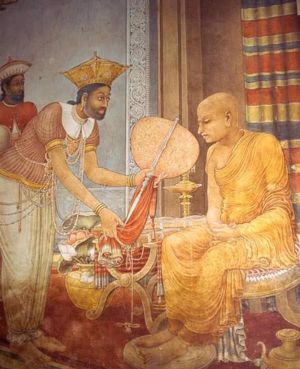CHOD AND DEHADANA
by Michelle Janet Sorensen
As I explained in the previous chapter, the philosophy of Buddhist Chod developed through a negotiation between tradition and innovation: Machik's teachings are firmly grounded in established Buddhist philosophies, while they provide innovative interpretations of key elements of those philosophies. In
the next two chapters, I turn to the ways in which Chod philosophies are reflected in practice. The praxis of Chod is also generated through processes of authentication and adaptation, as Machik uses and alters traditional Buddhist practices— especially those grounded in the body-mind of the practitioner—to support the lived realizaton of her philosophical concepts. Chod inscribes itself within the doctrines and discussions of Buddhist practice, while also revaluing analyses of the value and utility of the body.
One of the fundamental teachings of Buddhism is that there is neither an intrinsic identity nor an enduring self-nature that defines the human being. In juxtaposition with a fundamentally stable model of the interactions between body and mind, what I will call the “body-mind modality” expresses the processes of becoming human. (When I refer to the “body-mind” in what follows, it should be understood that I am invoking this “body-mind modality.”) Becoming human is a perpetual creative process that is necessarily mutually interdependent with the multiple perpetual processes that compose existence.
Buddhist discussions of body-mind modalities provide ways to think about, perceive, and experience being which are antithetical to dualisms such as mind and body, or subject and object, or self and other. Body-mind modalities are ways of recognizing that we are complexes of interdependent modes. Various schemas of human modality are not considered to be mutually exclusive in Buddhist thought; rather, they are seen as mutually informative. None of these models or conditions is thought of as a comprehensive ontology, but each suggests a possible way to appreciate the multiple factors and conditions that produce the modalities of sentient beings.
In Buddhist ontology, characterizations of the embodied being commonly integrate internal and external, necessary and contingent, individual and environmentally embedded. A human being is an experiencing, acting, developing process that integrates a complex manifold of mental and physical modes without beginning or end. To borrow John M. Koller's words, this body-mind modality can be understood as “a process constituted by interaction with other
processes in an ever-widening sphere that extends ultimately to the whole world. . . . [W]hat we think of as individual persons or beings are viewed within the tradition as junctures within the karmic network, analogous to the knots in a fishnet” (1993, 45). One's psychic and physical constituents are modes in the process of existing; being conscious is a necessarily embodied activity, and the embodiment of the human modality cannot be divorced from psychic
states. As a tradition that emphasizes the embodiment of its practitioners, Chod provides insight into this symbiosis between body and mind. Chod praxis uses concepts of the body and mind as heuristic tools for investigating lived experience and Buddhist theorizations of human existence. Within the doctrine of existence characterized by ignorance as the source of suffering, the Chod teachings of Machik describe and analyze the paradoxical nature of the body-mind. As in much traditional Buddhist thought, the body-mind in Chod is represented as a source of suffering, but the key innovation of Machik's teachings
is to reconceive the body-mind as the vehicle for cutting through ignorance and attachment with the aim of alleviating suffering. Chod praxis, as I will explain in the next two chapters, expresses and analyzes the body-mind modality of human being. In this chapter, I will consider how
Chod refigures the practice of using the body as an offering in order both to assimilate itself to and distinguish itself from traditional Buddhist praxis. First, I consider the significance of the body in Buddhist narratives of practice. Then I explore the place of dehadana, or “the gift of the body,” in Buddhist teachings. Building on these discussions, I examine how Chod praxis both emerges from and transforms the history of engagement with the body through Buddhist practice.
In his discussion of the body in Japanese Buddhist traditions, Kausalis notes that in Buddhist teachings the preliminary stages of cultivating mindfulness often involve breathing practices to allow the practitioner to become aware of how breath can be controlled autonomically through the body and/or
consciously through the mind, thus demonstrating an interconnection of the psychic and physical processes (1993a, 315). According to Kausalis, “it is almost impossible to change the expressive style of the mind-body complex through the mind alone. As soon as the mind-body complex encounters an idea alien or threatening to its present system, it initiates defensive action. To revise the mind-body complex, we must initiate a praxis with both mental and somatic components” (1993a, 314).
